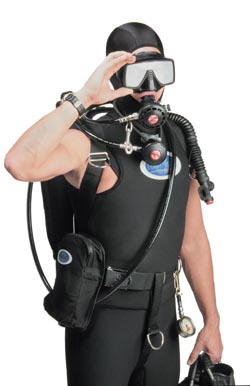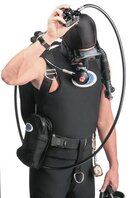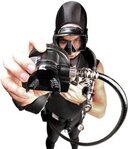Your wife is not a fill station. If you use more air on a regular basis than she does, you need a bigger tank, or an extra tank. If you rent tanks, you could always switch to side-mount and bring two 80's. With your current plan, if you use up your air, then use her air, you're both in trouble in case of an emergency.
You're looking for a more efficient way to do something that you shouldn't be doing in the first place. It's like oiling the cylinder on a revolver so you can play Russian Roulette easier.
So you want to give your wife a weird configuration just so you can use her like a mobile fill station?
There's no reason it wouldn't be functional, but you would now have a hose running across your wife, which could easily trap things in front of her (BC, weightbelt, access to pockets or equipment, etc) and using your air then hers leaves you without enough air for emergencies.
An octo on a recreational dive is used to get both divers to the surface in an emergency, not as a way to get free air and continue the dive.
flots.
I'm so glad you said this, flots.
My ex-husband, who had to be the most dangerous diver I've ever known, would do this all the time. He'd get really low on air, or even out of air, than use my octo. I'd try to surface right away, knowing how poor his air consumption was. He'd physically keep me from surfacing until we were so low on air that we sometimes have to literally do a CESA, sometimes from as deep as 80 feet.
While it did make me a stronger and more confident diver ( I'm sure I can handle a lot of problems as a DM that I may not have been prepared for otherwise), I would have rather not have ever experienced these types of dives and I'm glad we lived through them without injury.
Get yourself a larger tank or using doubles (back mount or sidemount) or just prepare to surface when you hit your rock-bottom. Learn gas management techniques. Gas management does not mean sharing tanks every dive.
Some women have very good SACs. I dive alongside most men with my AL63 ( for wetsuit diving) while they dive an 80 or larger and generally come up with more air. That's fine, because my back is also shorter, so short tanks fit me better. Plus, with my new husband/buddy, we're perfectly matched dive time when he uses his larger tank and I use my shorter tank.
If you're using a little bit of your wife's air at the beginning of the dive, like TSandM mentions, I much prefer the long hose with a bungees backup. I've only recently change out my hoses to this configuration and I just love how it works. It even cured my chronic jaw soreness that I've always gotten on any dive, no matter how short! I think my original hose on my primary was pulling my regulator to the right and I was clenching to hold the reg in my mouth.
Anyway, I did not find it difficult to become accustomed to the new hose configuration and I'm the "Queen" at being task-loaded by new gear changes. Any new gear change always requires a test run in the pool or very shallow shore dive but this particular change was as easy as any I've done.
My buddy loved the change, BTW. ( my DMC buddy) After practicing skills all summer with the short hose, doing buddy breathing and air shares going across the pool, he really appreciated the 7 foot hose. He's getting his changed as well.






